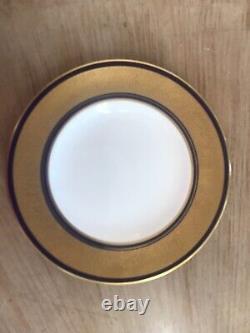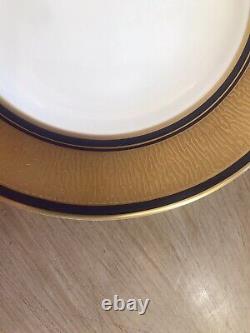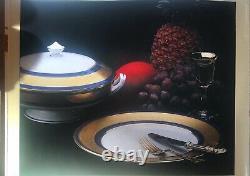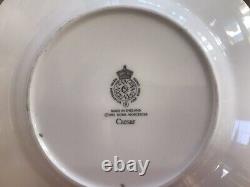Royal Worcester CAESAR, Lot/set of 104 pieces, wide 22k Gold Band, England






Wide 22k Gold Encrusted band on Blue. 2 Bread and Butter Plates. 14 tea saucers for footed tea cups. Additional 14 tea cups footed.
2 oval platters, 13 inches. 1 soup tureen base and. 1 cover for soup tureen. 1 covered vegetable dish base and.
1 lid for covered vegetable dish. 1 underplate for gravy boat (no gravy boat included, this is just the underplate which can be used for other things). 2 large sugar bowls (no lids, just the bowls). All pieces stored New, Never Used. Priced low for quick sale. If you are interested in one or more of these items, please let me know and I will be happy to make a special listing. The Worcester Royal Porcelain Co Ltd was formed in 1862. Over the years factory marking of pieces has evolved and although marks vary from impressed and hand written to printed emblems, the majority of bone china produced was marked in the way described below. The standard printed factory mark, included the number 51 in the centre that refers to the year 1751 when the Worcester Porcelain Company was founded by Dr John Wall.The mark can appear in any colour, and on a variety of materials. The marks almost always included a code to indicate the year of manufacture.
Between 1862 and 1875 specific indications of the year of manufacture are rare but may sometimes be found in the form of the last two figures of the date, eg 75 for 1875, printed below the standard mark. From 1867 a letter system was also used to indicate the year of manufacture. From 1876 the crown sits down to fit the circle. A = 1867B = 1868C = 1869D = 1870E = 1871G = 1872H = 1873I = 1874K = 1875L = 1876M = 1877N = 1878P = 1879R = 1880S = 1881T = 1882U = 1883V = 1884W = 1885X = 1886Y = 1887Z = 1888O = 1889a = 1890.
From 1891 pieces were coded with a system of dots and/or symbols with the addition of the words'Royal Worcester England'. 1891 ='Royal Worcester England' added1892 =One dot1893 =Two dots1894 =Three dots. This system continued until 1915 when 24 dots are arranged around the standard printed mark.
From 1916 a small star or asterisk appears below the mark. 1916 = below the mark1917 = and one dot1918 = and two dots. An extra dot was added each year until 1927 when 11 dots are arranged around the standard printed mark. 1928 =Oblong shape and the words'Made in England' added1929 =Diamond shape and Made in England1930 =Division mark and Made in England1931 =Two circles and Made in England1932 =Three circles and Made in England1933 =Three circles and one dot and Made in England1934 =Three circles and two dots and Made in England1935 =Three circles and three dots and Made in England.
This continued until 1941 when there were 9 dots and the triple circle mark. Between 1942 and 1948 no date code was used in the mark. 1949 =the letter V was introduced, ENGLAND added1950 =the letter W1951 =the letter W. (with one dot)1952 =the letter W.. (with two dots)1953 =the letter W.
(with three dots)1954 =the letter W.. (with four dots)1955 =the letter W... (with five dots)1956 =the letter W or R in a circle.. This series of codes continued until the 1960s when the dots are arranged around the R (signifying registered) in a circle. From 1966 the date coding system was rarely used and from the mid 1960s, a different format of factory stamp was also adopted for bone china tableware.The date included is the year of introduction of the design, not the date of manufacture. In April 1988 a system of year of manufacture identification that fitted with that used by Spode was introduced and an M within a diamond was incorporated below the factory mark. In January 1989 new factory stamps were used with an N in a diamond under the mark. Soon afterward black numbers were introduced to identify the lithographer.
These numbers were replaced with grey ones in August to reduce their visual impact. In 1990 all factory stamps reverted to the R in a circle under the mark. A printed grey lithographer identification number (eg 39) was used, plus a suffix to signify the year of manufacture.
Printed in greyPrinted in white39-0 = 199039-00 = 200039-1 = 199139-01 = 200139-2 = 199239-02 = 200239-3 = 199339-03 = 200339-4 = 199439-04 = 200439-5 = 199539-05 = 200539-6 = 199639-06 = 200639-7 = 199739-8 = 199839-9 = 1999. In the 1980s and 1990s some ranges of decorative pieces such as collectors plates and figurines were printed with very elaborate marks that include designers names, issue numbers and series names.
A huge variety of marks were used and most are self explanatory. Other materials - Since the 1880s separate systems of marks have been used for items made of earthenware (crownware) and Royal Worcester Vitreous. These sometimes follow the same dot code system, but hard porcelain rarely has any code and is therefore much more difficult to identify. We have a lot of china - takes time to take pictures of it all! This item is in the category "Pottery & Glass\Decorative Cookware, Dinnerware & Serveware\Plates".
The seller is "royal-english-china" and is located in this country: US. This item can be shipped to United States.- Handmade: Yes
- Production Technique: Pottery
- Country/Region of Manufacture: United Kingdom
- Style: Encrusted 22 karat gold rim
- Product Line: Royal Worcester
- Material: Bone China
- Pattern: Caesar
- Type: Lot 104 pieces
- Color: 22 carat GOLD TRIM
- Vintage: No
- Origin: England
- Brand: Royal Worcester
- Set Includes: Bread Plate, Cereal Bowl, Charger Plate, Cup, Dinner Plate
- Production Style: Art Pottery
- Time Period Manufactured: 1970-1979
- Original/Reproduction: England

